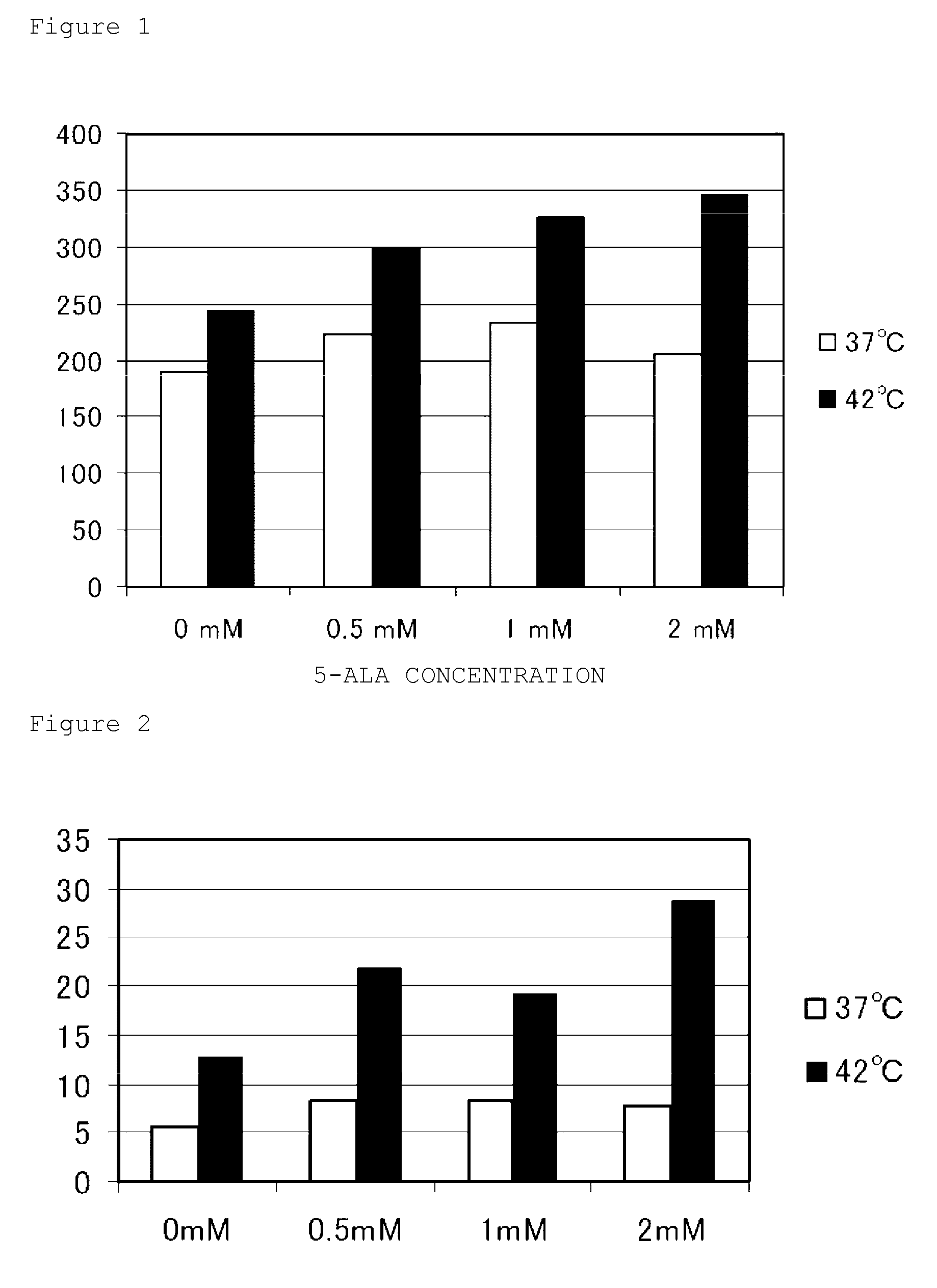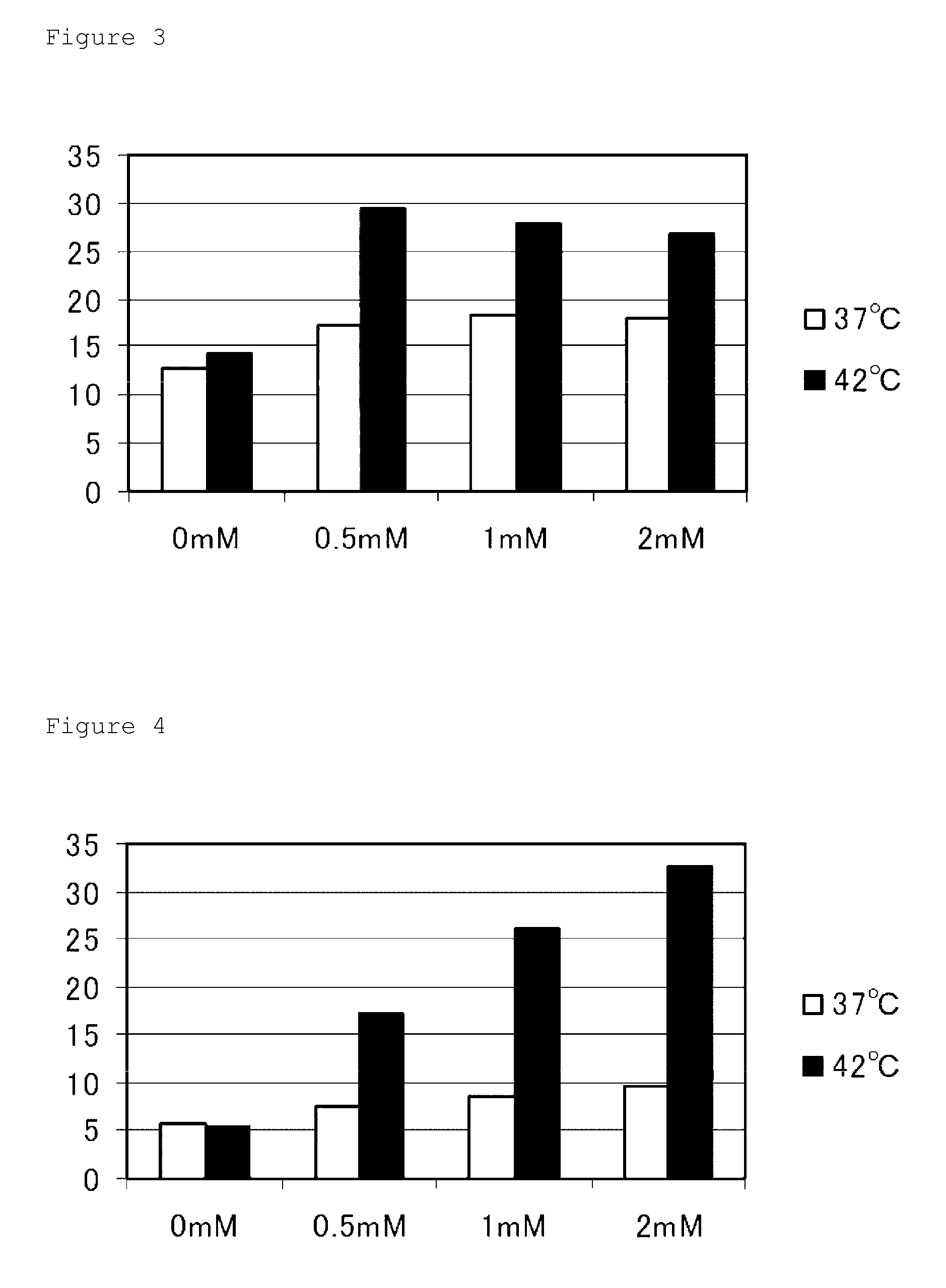Cancer heat therapy-enhancing agent
a cancer and thermotherapy technology, applied in the direction of biocide, organic chemistry, drug compositions, etc., can solve the problems of insufficient homeostasis, inability to effectively treat cancer without effective therapeutic agents and/or methods, and inability to be easily developed, so as to achieve sufficient anticancer effect, reduce patient's burden due to heating, and enhance the effect of anticancer
- Summary
- Abstract
- Description
- Claims
- Application Information
AI Technical Summary
Benefits of technology
Problems solved by technology
Method used
Image
Examples
example 1
Assay for Intracellular Reactive Oxygen Species
[0057]To investigate what kind of effect 5-aminolevulinic acids according to the present invention could exert on a level of intracellular reactive oxygen species during thermotherapy, human embryonic kidney-derived HEK293 cells and a DCF-DA fluorescent reagent (2′,7′-dichlorodihydrofluorescein diacetate; H2DCFDA) were used to perform an assay for measuring a level of intracellular reactive oxygen species. Note that this assay uses characteristics as follows. Cell-permeable H2DCFDA remains a non-fluorescent substance until it is oxidized in the cytoplasm of a viable cell. Once it enters the viable cell, its diacetate group is cleaved by an intracellular esterase. Then, the resulting molecule is further oxidized by reactive oxygen species to emit fluorescence. The higher the measured fluorescence level, the higher the level of intracellular reactive oxygen species. This assay was performed using the following procedure.
[0058]First, HEK29...
example 2
Hyperthermia Sensitivity Test Using Flow Cytometry
[0060]To investigate what kind of effect the addition of 5-ALA could exert on hyperthermia sensitivity of cancer cells, a hyperthermia sensitivity test was performed using a flow cytometry technique as follows.
[0061]First, a human fibrosarcoma cell line HT-1080 and a colon cancer-derived cell line Caco-2 were prepared as cancer cell lines, and a human fibroblast line WI-38 and a murine fibroblast line NIH3T3 were prepared as normal cell lines. Also, prepared was a human embryonic kidney cell line HEK293 transformed so as to overgrow like cancer cells. These cells were cultured at 37° C. for 24 hours in 10% FBS-containing DME medium, and split into 8 groups. Next, the medium was replaced by an FBS-free DME medium. Then, 5-aminolevulinic acid (5-ALA) was added to each group at a final concentration of 0.5 mM, 1.0 mM, or 2.0 mM, and cultured at 37° C. for 2 hours. After that, 10% FBS was added, and the resulting cell groups were incubat...
example 3
Hyperthermia Sensitivity Test Using Trypan Blue Reagent
[0064]A colon cancer-derived cell line Caco-2, a human hepatoma-derived cell line HepG2, a human gastric cancer-derived cell line KatoIII, and a human cervical cancer-derived cell line HeLa were used as cancer cell lines. A human embryonic kidney cell line HEK293 was used as cells transformed so as to overgrow like cancer cells. A human normal diploid fibroblast line WI-38, a murine fibroblast-like cell line NIH3T3, and a human embryonic lung-derived normal fibroblast MRCS were used as normal cells. Each of these cells was cultured at 37 or 42° C. for 24 hours in a DME medium containing 10% FBS and 5-ALA at a concentration of 0, 0.5, 1, or 2 mM, and treated with trypsin for cell harvest. Then, equal volumes of the harvested cell-containing solution and a trypan blue reagent were mixed, and the number of the cells was counted with a hemocytometer to calculate the fraction of dead cells (cells stained with trypan blue) (%; percent...
PUM
| Property | Measurement | Unit |
|---|---|---|
| temperature | aaaaa | aaaaa |
| temperature | aaaaa | aaaaa |
| temperature | aaaaa | aaaaa |
Abstract
Description
Claims
Application Information
 Login to View More
Login to View More - R&D
- Intellectual Property
- Life Sciences
- Materials
- Tech Scout
- Unparalleled Data Quality
- Higher Quality Content
- 60% Fewer Hallucinations
Browse by: Latest US Patents, China's latest patents, Technical Efficacy Thesaurus, Application Domain, Technology Topic, Popular Technical Reports.
© 2025 PatSnap. All rights reserved.Legal|Privacy policy|Modern Slavery Act Transparency Statement|Sitemap|About US| Contact US: help@patsnap.com



